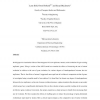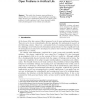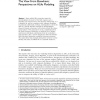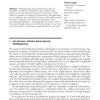ALIFE
2000
14 years 8 days ago
2000
Army ant colonies display complex foraging raid patterns involving thousands of individuals communicating through chemical trails. In this article we explore, by means of a simple ...
ALIFE
2000
14 years 8 days ago
2000
ALIFE
2000
14 years 8 days ago
2000
ALIFE
2000
14 years 8 days ago
2000
The evolution of simulated robots with three different architectures is studied in this article. We compare a nonmodular feed-forward network, a hardwired modular, and a duplicatio...
ALIFE
2000
14 years 8 days ago
2000
In this paper we examine the effects of the emergence of a new replicator, memes, on the evolution of a pre-existing replicator, genes. Using a version of the NKCS model we examin...
ALIFE
2000
14 years 8 days ago
2000
This article lists fourteen open problems in artificial life, each of which is a grand challenge requiring a major advance on a fundamental issue for its solution. Each problem is ...
ALIFE
2000
14 years 8 days ago
2000
We analyze a general model of multi-agent communication in which all agents communicate simultaneously to a message board. A genetic algorithm is used to evolve multi-agent languag...
ALIFE
2002
14 years 9 days ago
2002
Many artificial life researchers stress the interdisciplinary character of the field. Against such a backdrop, this report reviews and discusses artificial life, as it is depicted ...
ALIFE
2002
14 years 9 days ago
2002
A new approach called bioinspired engineering of exploration systems (BEES) and its value for solving pressing NASA and DoD needs are described. Insects (for example honeybees and ...
ALIFE
2002
14 years 9 days ago
2002
Self-replicating loops presented to date are essentially worlds unto themselves, inaccessible to the observer once the replication process is launched. In this article we present t...




